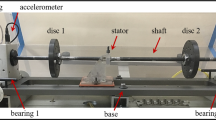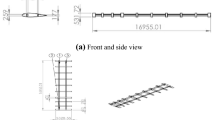Abstract
This paper presents validation of the helicopter rotor aeromechanics in descending flight. In its structural analysis, mixed variational geometrically exact beam model was used to capture nonlinear behavior of the rotor blade precisely. The present beam model was expressed by a mixed varational formulation in terms of the displacements, rotations, inertial forces, moments, and linear/angular momenta. Then displacements, inertial forces, and momenta can be directly extracted and solved simultaneously. And the finite-state dynamic inflow aerodynamics combined with blade element theory was used to predict induced inflow. The present results are compared by the wind tunnel test data for the higher-harmonic aeroacoustics rotor test (HART) II rotor with and without higher harmonic pitch control in descending flight. In the numerical results, trim control angles, section normal force, structural deflections, and structural loads were compared with those of the measurement. Predicted trim control angles and structural deflections show a good agreement with the measurement. But predicted flap bending moments show certain discrepancy with the measurement.
Similar content being viewed by others
References
B. G. van der Wall, 2nd HHC aeroacoustic rotor test (HART II) — Part I: Test Documentation -, Institute Report IB 111-2003/31, German Aerospace Center (DLR), Braunschweig, Germany (2003).
B. G. Van der Wall, 2nd HHC aeroacoustic rotor test (HART II) — Part II: Representative Results -, Institute Report IB 111-2005/03, German Aerospace Center (DLR), Braunschweig, Germany (2005).
B. G. van der Wall et al., An assessment of comprehensive code prediction state-of-art using the HART II international workshop data, American Helicopter Society International 68 th Annual Forum, TX, May (2012).
M. J. Smith et al., An assessment of CFD/CSD prediction state-of-art using the HART II international workshop data, American Helicopter Society International 68 th Annual Forum, Texas, May (2012).
R. T. Biedron and E. M. Lee-Rausch, Rotor airloads predictions using unstructured meshes and loose CFD/CSD coupling, 26 th AIAA Applied Aerodynamics Conference, August (2008).
T. Simth and C. E. S. Cesnik, Numerical investigation of integral twist actuation for BVI noise reduction, American Helicopter Society International 62 nd Annual Forum, Phoenix, Arizona, May (2006).
J.-S. Park and S. N. Jung, Comprehensive multibody dynamics analysis for rotor aeromechanics predictions in descending flight, The Aeronautical Journal, 116 (1177) (2012) 229–249.
J. W. Lim and A. C. B. Dimanlig, An investigation of the fuselage effect for HART II using a CFD/CSD coupled analysis, Proc. of the American Helicopter Society Specialist’s Meeting, 2 nd International Forum on Rotorcraft Multidisciplinary Technology, Seoul, Korea, October (2009).
M. Amiraux, J. D. Baeder and S. N. Koushik, Improved correlation with the HART-II rotor test data using coupled CSD/CFD and three levels of numerical modelization, Proc. of the 38 th European Rotorcraft Forum, Amsterdam, Netherlands, September (2012).
J.-S. Park, Multibody analyses for performance and aeromechanics of a rotor in low-speed flight, Aircraft Engineering and Aerospace Technology, 86 (2) (2014) 33–42.
M. Potsdam, H. S. Yeo and W. Johnson, Rotor airloads prediction using loose aerodynamic/structural coupling, American Helicopter Society International 60 th Annual Forum, Baltimore, MD, June (2004).
W. Johnson, CAMRAD II, Comprehensive analytical model of rotorcraft aerodynamics and dynamics, Johnson Aeronautics, Palo Alto, California (1992–2005).
G. Bir et al., University of maryland advanced rotor code (UMARC): Theory manual, technical report UM-AERO94-18, Center for Rotorcraft Education and Research, University of Maryland, College Park, July (1994).
O. A. Bauchau, DYMORE users’ manual, School of Aerospace Engineering, Georgia Institute of Technology, Atlanta, GA, May (2006).
D. H. Hodges, A mixed variational formulation based on exact intrinsic equations for dynamics of moving beams, International Journal of Solids and Structures, 26 (11) (1990) 1253–1273.
X. Shang, Aeroelastic stability of composite hingeless rotor with finite state unsteady aerodynamics, Ph.D. Dissertation, School of Aerospace Engineering, Georgia Institute of Technology, Atlanta, GA, May (2002).
T. Cheng, Structural dynamics modeling of helicopter blades for computational aeroelasticity, M.S. Dissertation, Dept. of Aeronautics and Astronautics, Massachusetts Institute of Technology, Cambridge, MA, May (2002).
K. Kim, The effect of the blade nonlinear deflection upon fluid-structure interaction analysis in helicopters, M.S. Thesis, Seoul National University, February (2007).
T. Y. Chun et al., Structural analysis of a bearingless rotor using an improved flexible multi-body model, Journal of Aircraft, 51 (1) (2013) 539–550.
D. A. Peters and C. J. He, Finite state induced flow models Part II: Three-dimensional rotor disk, Journal of Aircraft, 32 (2) (1995) 1493–1511.
M. Kelly, K. Duraisamy and R. Brown, Predicting blade vortex interaction, airloads and acoustics using the vorticity transport model, Proc. of the American Helicopter Society 9 th Aeromechanics Specialist’s Meeting, San Francisco, January (2008).
Author information
Authors and Affiliations
Corresponding author
Additional information
Recommended by Associate Editor Cheolung Cheong
Hanyeol Ryu received his B.S. and M.S. degrees in Aerospace Engineering from Chonbuk National University in 2005 and 2007. His research interests include rotorcraft dynamics, nonlinear structural dynamics and aeroelasticity.
Sang Joon Shin received his M.S. and Ph.D. degrees in Aeronautics and Astronautics from Massachusetts Institute of Technology in 1999 and 2001, respectively. Since 2003, he has been a professor at the School of Mechanical and Aerospace Engineering in Seoul National University. His research interests include aeroelasticity, rotorcraft dynamics, and smart structures.
Rights and permissions
About this article
Cite this article
Ryu, HY., Shin, SJ. Prediction of the aeromechanics for HART II rotor in descending flight using mixed variational geometrically exact beam analysis. J Mech Sci Technol 29, 141–150 (2015). https://doi.org/10.1007/s12206-014-1221-0
Received:
Revised:
Accepted:
Published:
Issue Date:
DOI: https://doi.org/10.1007/s12206-014-1221-0




